Deciphering the 7th Party Congress: A Teaser for Greater Change?
From one perspective, the 7th Congress of the Workers’ Party of Korea (WPK) was a monotonous event, long on rhetoric and short on major policy and personnel changes. No substantive policy announcements took place, and many top officials sat on a rostrum for four days and ultimately kept their jobs. Throughout hours of speeches, Kim Jong Un reiterated North Korea’s nuclear weapons policy and underscored the country’s cautious diplomatic approach to the South.
This disappointed a number of observers who had predicted major economic or political announcements. Some of these Pyongyang watchers may have projected too much significance onto the Party Congress as the first such gathering in 36 years; some might have even issued facetious prognostications to draw a sharp contrast with the anticlimax they actually expected. Though DPRK state media stoked considerable anticipation,[1] the WPK Central Committee emphasized months ago that major changes had already occurred[2] and the Party Congress was primarily intended to rededicate and reinforce Kim Jong Un’s rule.[3]
Indeed, the gathering successfully reset some of North Korea’s political culture and modified the political system to complement Kim Jong Un’s leadership behavior, potentially enabling the Suryong to pursue more substantive policy changes going forward. The event reaffirmed the WPK’s control of the Korean People’s Army (KPA), consummating steps to that end taken over several years by the current supreme leader.[4] In addition, participants unveiled several notable personnel changes and redefined senior party leadership positions, such as reorganizing party departments, reducing the influence of the KPA and restricting political power to a smaller population of stakeholders. This could ease resistance, both in discussions and bureaucratically, to policy modifications that Kim Jong Un might want to pursue because he has established clearer and more formal lines of authority and won’t have to kowtow to the entrenched interests of certain constituency groups.
State media said Kim Jong Un’s remarks to the 7th Party Congress had unveiled a “blueprint” for the country.[5] The word “blueprint” indicates a sketch and direction, but not a whole policy structure. Therefore, it is possible that the regime will promulgate more substantive policy updates and changes to the political system at future forums in the next few years.
Figure 1. View of the platform at the 7th Party Congress.
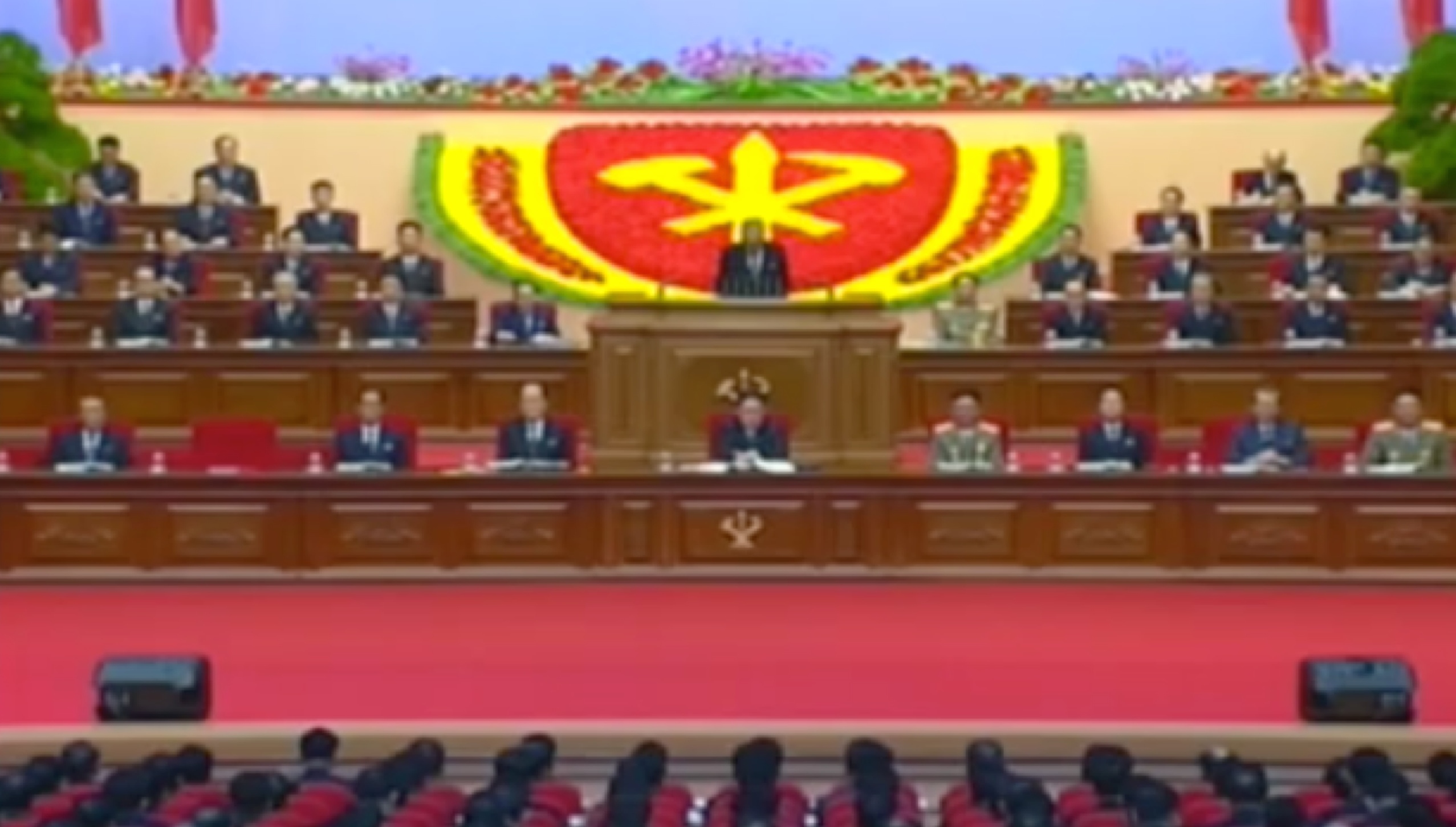
Kim Jong Un Claims Expansive Leadership Roles
Kim Jong Un dominated the 7th Party Congress with his speeches and delivery of the WPK Central Committee report which extended over nearly three days. North Korean political history contains no precedent of a supreme leader speaking at such length. Organizers curtailed the significance of supporting speakers, who typically endorse reports or rhetoric at political gatherings on behalf of different constituencies. The second most frequent speaker at the Congress was Kim Yong Nam, Supreme People’s Assembly (SPA) Presidium President and the country’s nominal head of state. Their double act clearly, yet subtly, affirmed the identities of the top leaders to North Korean citizens and WPK members.[6]
Analysts should continue to parse, interpret and deconstruct Kim Jong Un’s remarks at the Congress, but three things about his statements are of particular note. First, he emphasized repeatedly the concept of “self-development first,” which state media introduced in January and has since come to augment the current understanding of Juche. “Self-development first” will most likely be applied to whatever substantive policies result from the five-year strategy for state economic development, the second notable element of Kim Jong Un’s remarks at the Party Congress.[7] While few details emerged about the five-year plan through state media, this is the first multiyear economic plan[8] announced and explicitly endorsed by North Korea’s supreme leader since 1986.[9] The plan itself appears to be an attempt by Kim Jong Un to assume public responsibility as the initiator and arbiter of economic policies, a role his father avoided.[10]
The final notable element of Kim Jong Un’s speeches was a relatively candid statement about his role as leader of the WPK. In his closing remarks on the last day of the Party Congress, he offered a variant of the oft-repeated pledge to hold “the leaders in high esteem,” and instead said he would hold “our people in high esteem.” This is an extension of state media rhetoric about “people first” and “functionaries serve the people,” placing North Korean citizens in the same rhetorical company as Kim Il Sung and Kim Jong Il. Whether for sheer drama or alluding to opposition to his policy pursuits, he pledged to do this “even if my body is torn to pieces, and I fall.”[11]
Figure 2. WPK Central Committee after the 7th Party Congress.
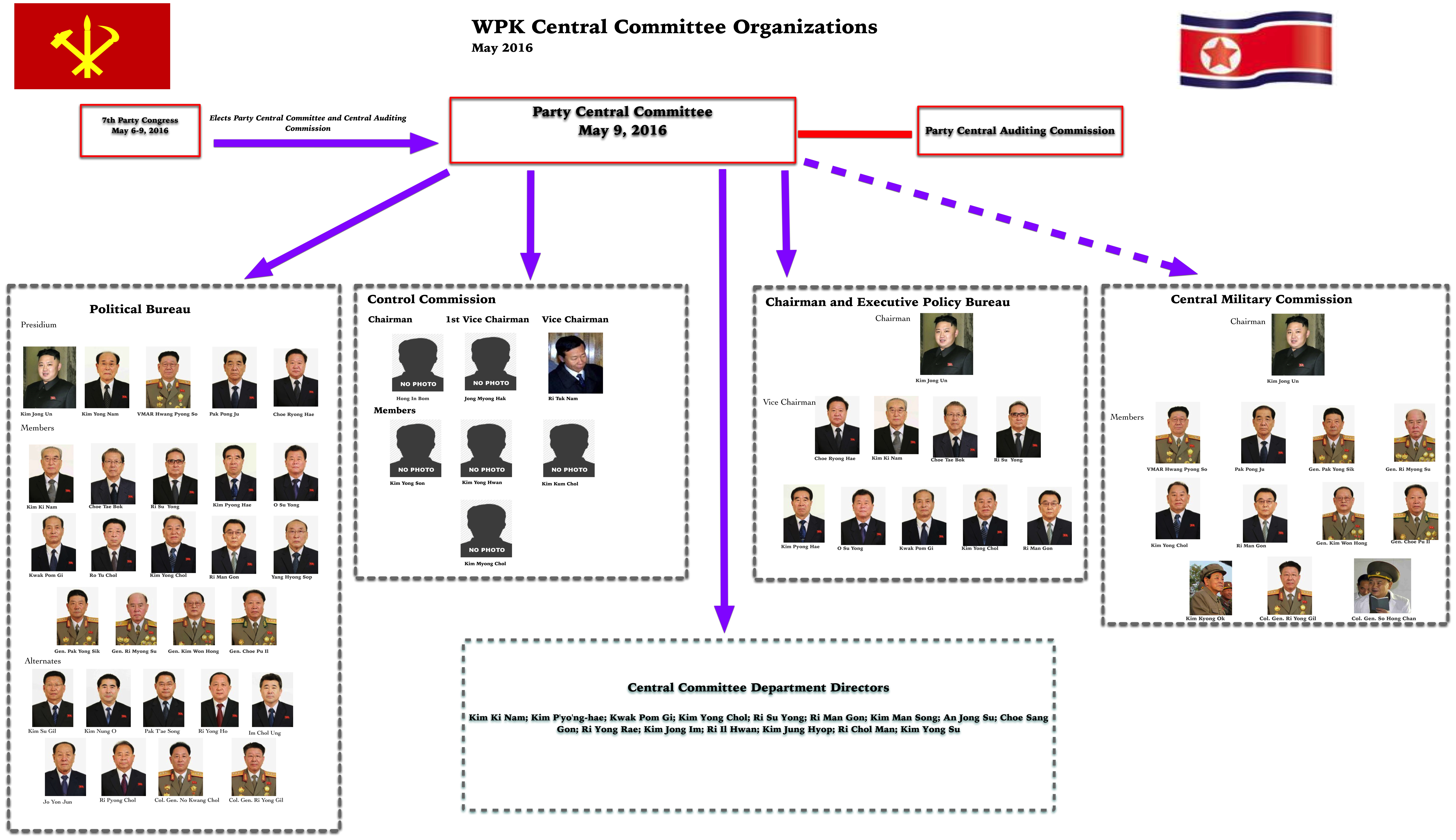
Another Time Warp: WPK Revamps Titles and Replaces Secretariat
The major organizational change announced at the 7th Party Congress was the reinstatement of the WPK chairmanship, to which Kim Jong Un was elected, and several WPK vice chairmanships. The re-establishment of these 1960s-era titles took place alongside the dissolution of the Secretariat—previously the WPK Central Committee’s apparatus for policy implementation and enforcement—and its replacement by a new central party power organization called the Executive Policy Council.[12][13] As such, secretaries (i.e., members of the Secretariat) were retitled as chairman and vice chairmen from the central party all the way out to basic party organizations. As at previous national party gatherings during the last six years,[14] these changes were effected on the sidelines of a WPK Central Committee plenary meeting.[15]
It remains to be seen whether or how the Executive Policy Council will differ from the Secretariat in its role, function and effectiveness. Every senior official who held the position of WPK Central Committee Secretary at one point eventually became a WPK Vice Chairman, while former Foreign Minister Ri Su Yong[16] and WPK Central Committee Munitions (machine-building) Industry Department Director Ri Man Gon[17] assumed additional roles.[18] No additional changes to the composition of the former Secretariat are apparent.[19]
WPK Central Committee: Possible New Departments Emerge During Power Handoff
Two trends emerged in elections held at the 7th Party Congress for the WPK Central Committee[20] and two of its power organizations, the Political Bureau and Central Military Commission. First, the WPK Central Committee saw a modest expansion from 2010 of its total membership and number of alternate members.[21] Over half of its membership (54.9%) is new, with 129 new members and 106 old ones, according to the ROK Ministry of Unification.[22] A cursory examination of the body’s alternate or candidate members reveals some generational change in the WPK leadership; the alternates include members in their 30s and 40s—the next generation of DPRK political elites—as well as individuals who were elected as full members in 2010 and have since retired.[23]
Second, the number of WPK Central Committee Department Directors elected on May 9, 2016, suggests the creation of two new departments. Available information does not confirm if new departments were established or any previously consolidated departments have been spun off into separate entities, and observers should carefully monitor state media for further details on this apparent development. The mission and function of WPK Central Committee departments and the released personnel register strongly suggest that any new entities are supporting the formulation and execution of Kim Jong Un’s five-year economic development plan.[24]
Figure 3. WPK Political Bureau Members and Alternates.
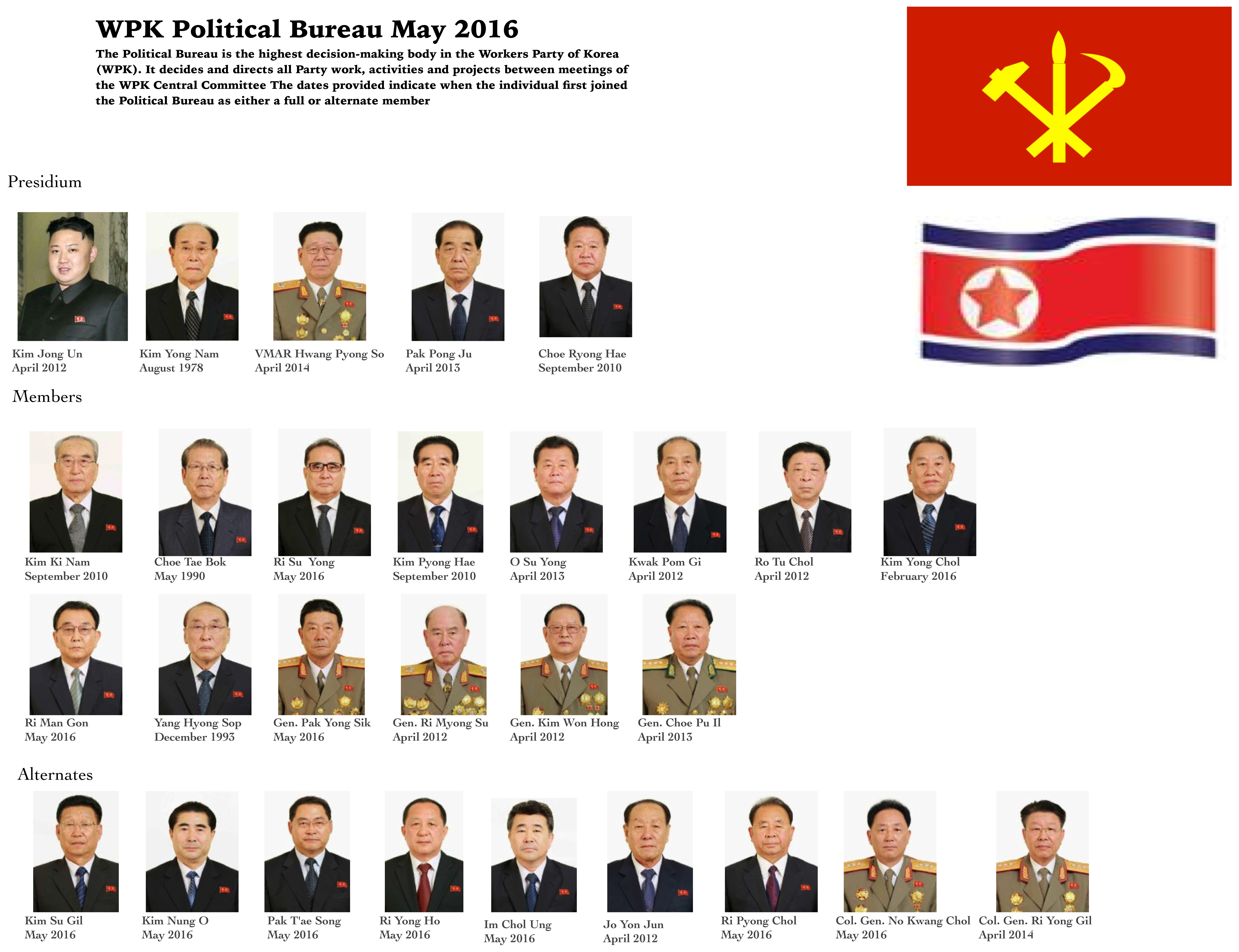
Political Bureau: Members Gain Stature as Military Role Wanes
Meanwhile, the smaller Political Bureau and Central Military Commission (CMC) each saw its membership contract, leaving a cohort of core senior party officials. The number of uniformed officers of the KPA and internal security services decreased within the organizations, both of which are subordinate to or organized by the WPK Central Committee.
The first meeting of the 7th Term WPK Central Committee on May 9 elected a total of 28 Political Bureau members and candidate members, giving the office its smallest elected membership since it was revived as an active political body in 2010. Though its total membership has dropped, it has gained additional full (or regular) members.[25] Some additional changes in Political Bureau composition included:
- Only six Political Bureau members and alternates are uniformed officers of the armed forces and internal security services, indicating the KPA’s waning influence in the WPK.[26]
- The Political Bureau Presidium (standing committee) has only one armed forces representative.[27]
- Senior party officials now appear ahead of KPA officials in the state media’s print and broadcast coverage of the Political Bureau, including a photo array published in the May 10 edition of Rodong Sinmun.[28][29]
- Balancing out perceptions of diminished KPA political influence, three officials with Political Bureau status (one full member and two alternates) are senior party officials who migrated from the KPA to the WPK apparatus within the last two years.[30]
- Every WPK Vice Chairman now has full member status on the Political Bureau. Prior to the 7th Party Congress, some in this cohort were WPK Central Committee Secretaries but not full Political Bureau members. This crossover, in which all WPK Vice Chairmen are also full Political Bureau members, creates a core power cohort at the top of the WPK’s body politic, enhancing (at least superficially) party authority in the regime.
- Nearly every Political Bureau member and alternate has traveled outside the DPRK on official business, either as a head or member of an official delegation or as part of Kim Jong Il’s entourage during his 2010 and 2011 unofficial visits to China and Russia. These individuals, with their international experience form a significant bench, to dispatch higher-level and more diverse delegations on visits abroad.
- Fourteen Political Bureau members and alternates had prior experience as WPK Central Committee Department Directors, Senior Deputy or Deputy Directors; this gives the cohort practical experience in shepherding policies at the heart of the regime from formulation to execution.
- As in 2010, the Political Bureau has three total members (two full members and one alternate member) tasked with external relations and foreign policy and commensurate career experience therein.[31]
- At least seven Political Bureau members and alternates have familial or social ties to Kim Jong Un’s parents, Kim Jong Il and Ko Yong Hui.
Figure 4. May 10, 2016 edition of Rodong Sinmun showing WPK Political Bureau Members and Alternates with government and party officials ahead of KPA officials.
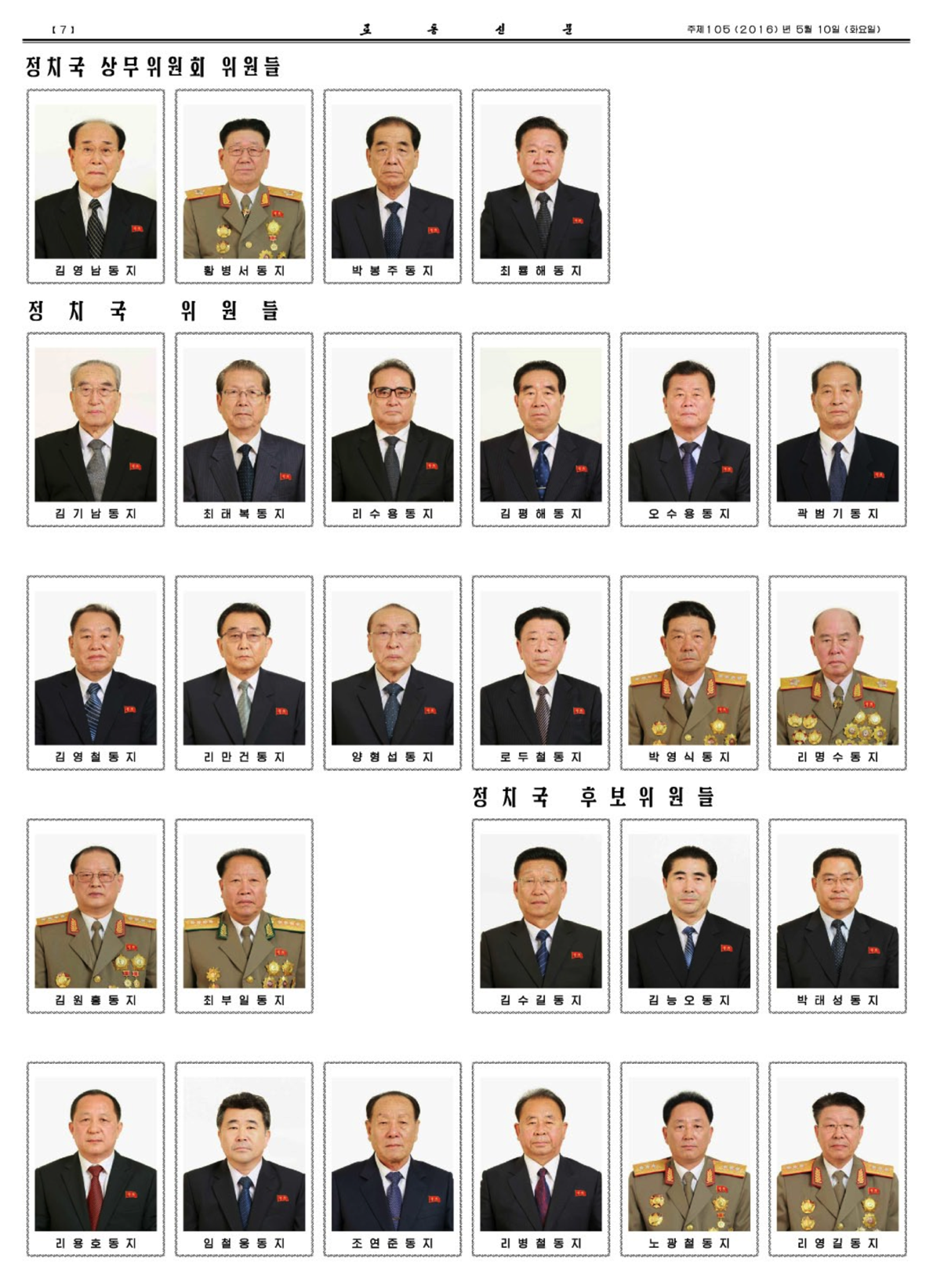 Figure 5. WPK Central Military Commission members.
Figure 5. WPK Central Military Commission members.
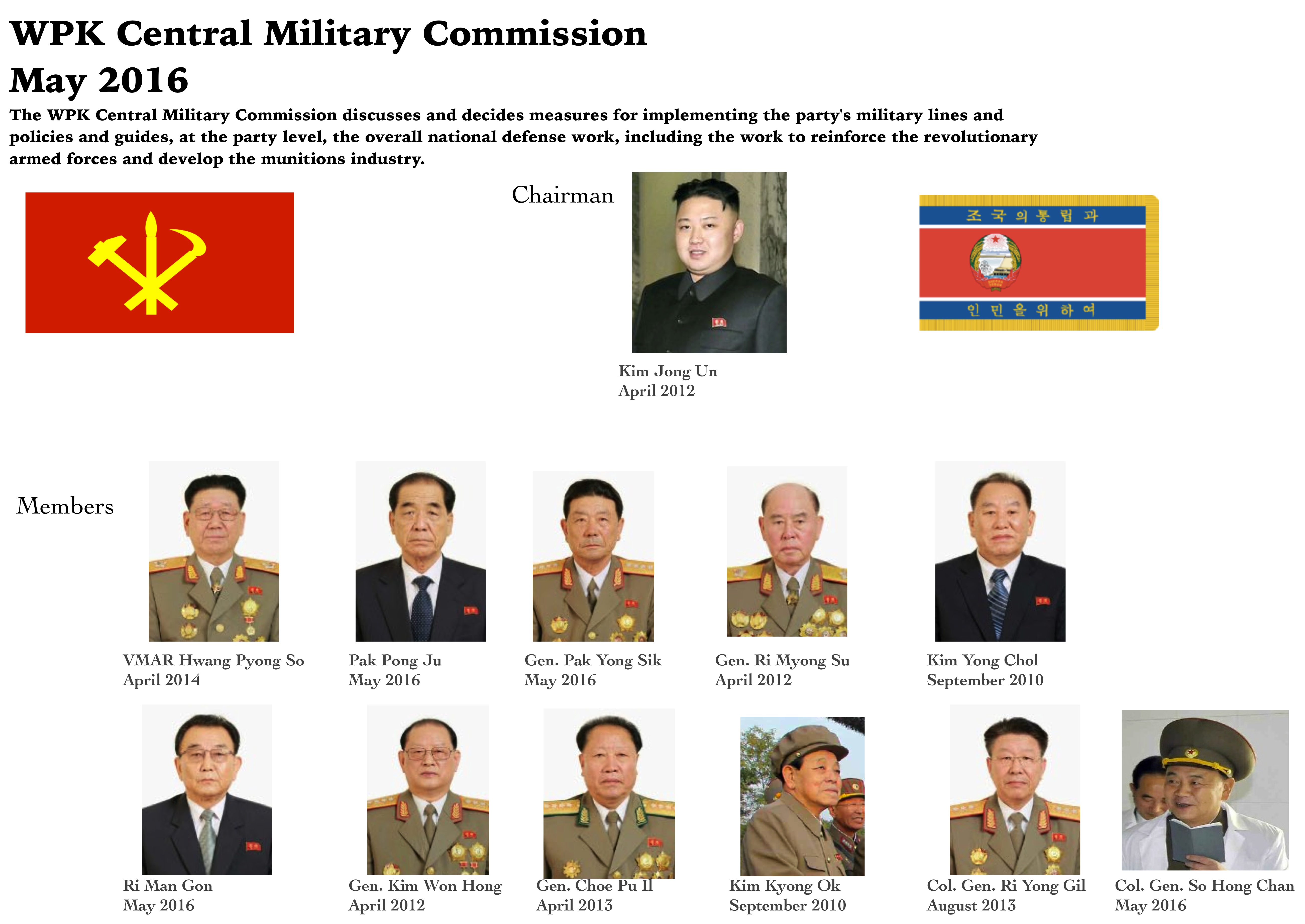
Central Military Commission: Cabinet Gains New Influence
The most notable CMC personnel appointment, as some observers previously noted, is that of DPRK Premier Pak Pong Ju, who can now argue for Cabinet interests in how resources are allocated.[32] One of the CMC’s primary functions is to authorize defense and munitions spending[33] and product orders,[34] and to determine how natural resources and products from military-controlled production units are earmarked and distributed domestically and for sale abroad. With sanctions affecting what the DPRK can and cannot export, Pak Pong Ju’s presence on the CMC creates a chance that some natural resources normally sold abroad by KPA elements will be redirected and used in domestic economic development. If Kim Jong Un intends to adopt “self-development first” as a practical policy line, then he might do so by supporting Pak in redirecting into state development the natural resources that the KPA can no longer sell abroad.
The CMC shrank to 12 members from a membership that previously ranged between 15 and 20. The position of Vice Chairman and a number of positions historically occupied by the directors or commanders of key KPA organizations were eliminated. The incumbent members of the CMC removed[35] on May 9 were re-elected to the WPK Central Committee, and some attended the 7th Party Congress as either platform participants or delegates.
Unlike previous CMCs, the current commission contains no low first-tier commanders or directors, only uniformed personnel who are all top members of the KPA high command or leading officials of the Ministry of State Security and Ministry of People’s Security. This exclusion of lower-level officers reflects the removal of a whole group of senior officials with equivalent positions in the DPRK national security community.[36] Meanwhile, crossover between memberships of the CMC and Political Bureau has created a small population of officials who can exert significant influence over policy decisions (and who would assume additional responsibility for perceived blunders).
Conclusion
The 7th Party Congress had a lot of rhetoric and pageantry, but it was not the last word on Kim Jong Un’s goals and vision for the country. While significant parts of North Korea’s political system were adjusted, the Party Congress was not an appropriate setting for Kim to unveil major policy shifts, given the event’s traditional focus on rhetoric, ideological lines and organizational and personnel changes within the WPK. Early pronouncements on the 7th Party Congress are shortsighted because, like most political party gatherings, the North Korean party congresses are forums for talking points and lofty goals, not line-item technocratic recitations of substantive policies.
While its effectiveness remains to be seen, the latest party gathering reset parts of the political system in ways that allow Kim Jong Un to pursue substantive action. The roles and functions of party institutions have been clarified and publicly declared strengthened. The new party leadership includes individuals migrated from the Cabinet and the DPRK national security apparatus and reflects an emphasis on substantive work experience rather than ideological purity. This combination could create the conditions through which policies can be formulated, tried, executed and tweaked at future gatherings such as a meeting of the Supreme People’s Congress.[37]
——————————————-
[1] One editorial described the upcoming gathering as a “historical event demonstrating the revolutionary faith of the Korean people. See Jong Son Chol, “WPK’s Seventh Congress Will Be Recorded as Glorious One of Victors,” Rodong Sinmun, May 2, 2016, http://www.rodong.rep.kp/en/index.php?strPageID=SF01_02_01&newsID=2016-05-02-0009.
[2] In a declaration of the 70-day campaign given to the WPK Political Bureau, the WPK Central Committee stated that “great changes have taken place in the people’s destiny and life and the country has advanced through years of changes and miracles at the step of fresh leap with the Party’s congresses as a watershed.” See “70 Day Speed Battle Declared by WPK Political Bureau, NK Leadership Watch, February 27, 2016, https://nkleadershipwatch.wordpress.com/2016/02/24/70-day-speed-battle-declared-by-wpk-political-bureau/.
[3] Some DPRK state media did reference changes that were not explicitly linked to the outcomes of the Party Congress: “Korean people are now displaying matchless heroism and devotion to bring about epoch-making changes on the occasion of the Seventh Congress of the WPK while firmly trusting and following it as a beacon of genuine life and mother.”
[4] In addition to verbal statements, these steps have included indoctrination efforts targeted toward KPA officers and service members, as well as party actions to influence military policies, defense acquisition and resource allocation.
[5] State radio reportedly said Kim had used the Party Congress to “unveil the brilliant blueprint to bring forward the final victory of our revolution.” See James Pearson, “North Korean leader hails nuclear success in opening congress,” Reuters, May 7, 2016, http://www.reuters.com/article/us-northkorea-congress-opening-idUSKCN0XX1FI.
[6] The international media devoted considerable coverage to Kim Jong Un’s sartorial decisions, with some justification. For four days, the Suryong wore pinstriped suits and dark neck ties in lieu of the usual Zhongshan suit favored by Kim Jong Il, a nod to Kim Il Sung that strengthened his appearance of independence from his father. Kim Jong Un’s emerging public identity places him in close step with other senior WPK officials. For a post-Congress rally-cum-parade, he wore the Zhongshan suit in a fashion similar to other top party officials, potentially indicating that he feels secure enough in his leadership role to dress like other party officials.
[7] The new ideological phrase appears in part to address potential problems with imports and exchanges resulting from unilateral and multilateral sanctions adopted following the country’s fourth nuclear test and its February 2016 space launch.
[8] There has been some linguistic quibbling as to whether or not Kim Jong Un announced a “plan” or a “strategy.” Plans and planning form part of the primary definitions and conventional usage of the word strategy.
[9] The last Seven-Year Plan was deemed a failure during a plenary meeting of the WPK Central Committee in December 1993. Interestingly, the WPK Central Committee did not hold any other plenary meetings until September 28, 2010, the same meeting which confirmed Kim Jong Un to party positions necessary to be Kim Jong Il’s hereditary successor.
[10] Kim Jong Un also conveyed the regime’s official perspectives on various domestic development and external relations issues at the 7th Party Congress. No matter how his nuclear and economic policy pronouncements are received and interpreted in Seoul, Washington and elsewhere, his remarks usefully summarize the regime’s perspective and posture, giving foreign policymakers an alternative to sorting through numerous communiques and statements from different DPRK government and security organizations.
[11] Specifically, he said: “Cherishing deep in my heart the greatest trust and expectations of you who have entrusted me with the heavy responsibility of the Chairman of the dignified Workers’ Party of Korea, I will fight on undauntedly, offering myself without regret in the sacred struggle to hasten the final victory of the cause of the Juche revolution pioneered in Mount Paektu; and I pledge myself to remain faithful to the revolution, holding our people in high esteem invariably and selflessly at any time, at any place and at any moment, even if my body is torn to pieces and I fall.”
[12] Initial state media coverage of this new institution identified it as the Executive Policy Bureau, but subsequent news items identify it as the Executive Policy Council.
[13] Provincial and local party committees were previously led by chief secretaries and secretaries which formed the party committee’s secretariat. After the 7th Party Congress, these positions and organizations have been replaced by a chairman, a vice chairman and an Executive Policy Office. According to DPRK state media, these changes will also affect basic party organization—party cells, primary party committees and the like—which were led by a secretary and a deputy secretary and now led by a chairman and vice chairman (i.e. party cell chairman).
[14] At the 7th Party Congress, changes to the WPK Central Committee’s power organizations such as the Political Bureau and Central Military Commission were effected during WPK Central Committee plenary meetings and then announced at the larger party gathering. Technically, the party congress elects members of the Central Committee, which in turn elects members of the party power organizations along with department directors and the editor of Rodong Sinmun. The 3rd Party Conference in 2010 and the 4th Party Conference in 2012 also used this system.
[15] The first meeting of the 7th WPK Central Committee took place on May 9.
[16] Ri Su Yong (a.k.a. Ri Chol) became WPK Vice Chairman for International Affairs and concurrent WPK Central Committee International Affairs Department Director, assuming the latter position from Kang Sok Ju, a terminally ill official who remains a member of the WPK Central Committee.
[17] Ri Man Gon became WPK Vice Chairman for Munitions (machine-building) Industry and concurrent WPK Central Committee Munitions (machine-building) Industry Department Director. He has succeeded Pak To Chun as the leading official of the DPRK’s munitions industries, although Pak hasn’t quite yet retired and had managerial roles in the fourth nuclear test and the February space launch. Ri Man Gon was appointed department director around December 2015.
[18] All but two of the WPK Vice Chairmen are concurrently WPK Central Committee Department Directors for their respective policy portfolios. Both before and after the 7th Party Congress, the two officials are WPK Vice Chairman for Workers’ and Social Organizations Choe Ryong Hae, who is also Chairman of the State Physical Culture and Sports Commission, and WPK Vice Chairman for Science and Education Choe Thae Bok, who is also Chairman of the Supreme People’s Assembly. The department directorships are held by Ri Il Hwan and Choe Sang Gon, respectively. Some Pyongyang watchers claim that Choe Ryong Hae’s Vice Chairman/Secretariat portfolio is in Military Affairs; that was true in 2010, but it is no longer the case.
[19] One lingering question is whether Vice Marshal Hwang Pyong So is now de facto WPK Vice Chairman for Military Affairs in his capacity as Director of the KPA General Political Department (GPD). Under the former Secretariat system, this was the case.
[20] This larger party organization is considered the WPK’s supreme authority between the convocation of Party Congresses.
[21] The WPK Central Committee’s total membership grew to 129, up from 124 in 2010, and the number of alternate members increased by one, to 106. See “Names of N. Korea’s WPK Central Committee Members Revealed,” Korean Broadcasting System, May 10, 2016, http://world.kbs.co.kr/english/news/news_IK_detail.htm?No=118891.
[22] “Recent N. Korean congress replaces over half of party’s central committee,” Yonhap, May 13, 2016, http://english.yonhapnews.co.kr/news/2016/05/13/0200000000AEN20160513008000315.html.
[23] Current DPRK Premier Pak Pong Ju was elected a WPK Central Committee alternate member during the 6th Party Congress in 1980.
[24] Of particular interest here might be the WPK Central Committee Planning and Finance Department which, among others, consolidated the WPK Central Committee Agriculture, Heavy Industry and Economic Policy Inspection Departments. This consolidation process, a reaction by ideologues to the July 2002 Measures, was overseen by former State Planning Commission Chairman Pak Nam Gi, who became the department’s director in 2005 and held that position until he was executed in February 2010 following a botched currency swap.
[25] In 2016 there are 19 full members whereas in 2010 there were 16 full members.
[26] In 2010, 11 out of 31 total Political Bureau members and alternates were drawn from the KPA. Among those removed as full members were two National Defense Commission Vice Chairmen, Vice Marshal Ri Yong Mu and General O Kuk Ryol, both of whom were in the first row of the platform at the 7th Party Congress and both of whom were re-elected to the WPK Central Committee. When state television cameras captured General O during the 7th Party Congress, he was sitting still with a stern expression on his face, in contrast to Vice Marshal Ri, who was observed taking notes. Their removal from the Political Bureau might foreshadow personnel changes to the National Defense Commission during the next Supreme People’s Assembly session or the establishment of a different supreme power organization involved in defense policy and command and control of the DPRK’s national security community.
[27] This representative is Vice Marshal Hwang Pyong So, Director of the KPA General Political Department and literally the WPK’s boss in the KPA. In 2010, the Presidium had two armed forces representatives.
[28] Until after the 7th Party Congress, the KPA’s top two officials—the Minister of the People’s Armed Forces and Chief of the KPA General Staff—were among the first half-dozen names called or listed. This applied to the listing and photo array for Political Bureau alternate members, in which party and state officials were listed ahead of the two KPA officials.
[29] The Political Bureau has met in expanded sessions on several occasions since 2010. It remains to be seen whether this will continue after the 7th Party Congress.
[30] These are full Political Bureau member Kim Yong Chol, a former Vice Chief of the KPA General Staff and head of the Reconnaissance General Bureau who was installed as head of intelligence and South Korean Affairs in January 2016; alternate Political Bureau member Kim Su Gil, a former MPAF official, who was appointed chief secretary (now chairman) of the Pyongyang City WPK Committee in 2014 following a purge of Jang Song Thaek-linked officials on the capital city’s party organization; and Ri Pyong Chol, a former KPA Air Force commander who was appointed a WPK Central Committee senior deputy director in late 2014.
[31] Ri Yong Ho is the first Foreign Minister to have Political Bureau status since, successively, Ho Tam and Kim Yong Nam. Ri Yong Ho’s migration will mark another personnel change to the DPRK diplomatic interface with the United States within a year. In 2015, the former head of the Foreign Ministry’s American Affairs Division, Ri Gun, was appointed DPRK Ambassador to Poland and was replaced by Choe Son Hui, who works closely with Ri Yong Ho. Ri Yong Ho is a princeling, said to be the son of the late Ri Myong Je, a former KCNA reporter who later managed Kim Jong Il’s households and some of the late leader’s personal affairs.
[32] Pak’s CMC membership merits close attention; he previously served as Minister of Chemical Industry at a time when the DPRK actively produced chemical weapons.
[33] Previous DPRK Premier officeholders have been members of senior-level work teams involved in spending and resource allocation in support of weapons of mass destruction (WMD) research and development. DPRK Cabinet departments contribute to WMD programs through university research institutions and production shops in state-owned enterprises, which contribute materiel to conventional and advanced arms production.
[34] These include the allocation of materials and components from the state-owned sector, which is under Pak’s purview.
[35] The ousted CMC members who remain on the WPK Central Committee and attended the 7th Party Congress include Guard Command Director General Yun Jong Rin, Military Security Command Director General Jo Kyong Chol, Special Operations Forces head Colonel-General Choe Kyong Song and Storm Force Commander Lieutenant-General Kim Yong Bok.
[36] One early misleading interpretation about CMC personnel appointments is that some officials were dismissed because of security failures or recent setbacks in missile development. This analysis was applied in particular to KPA Strategic Force Commander General Kim Rak Gyom, who was viewed as a scapegoat for recent missile testing setbacks. General Kim was re-elected to the WPK Central Committee and his status as head of the strategic rocket force command remained intact, despite past problems in missile testing.
[37] In addition, the rubberstamp parliamentary body must fill a number of Cabinet vacancies created during the 7th Party Congress. An upcoming SPA session might also see some changes to DPRK government bodies to improve consistency with Kim Jong Un’s new title as WPK Chairman, such as reviving the Central People’s Committee or reorganizing the National Defense Commission.
